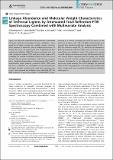Files in this item
Linkage abundance and molecular weight characteristics of technical lignins by attenuated total reflection-FTIR spectroscopy combined with multivariate analysis
Item metadata
| dc.contributor.author | Lancefield, Christopher S. | |
| dc.contributor.author | Constant, Sandra | |
| dc.contributor.author | de Peinder, Peter | |
| dc.contributor.author | Bruijnincx, Pieter C.A. | |
| dc.date.accessioned | 2019-04-19T14:30:04Z | |
| dc.date.available | 2019-04-19T14:30:04Z | |
| dc.date.issued | 2019-03-21 | |
| dc.identifier | 258658202 | |
| dc.identifier | c3caceaa-192d-4d96-b19c-e33c9a28dac9 | |
| dc.identifier | 30641616 | |
| dc.identifier.citation | Lancefield , C S , Constant , S , de Peinder , P & Bruijnincx , P C A 2019 , ' Linkage abundance and molecular weight characteristics of technical lignins by attenuated total reflection-FTIR spectroscopy combined with multivariate analysis ' , CHEMSUSCHEM , vol. 12 , no. 6 , pp. 1139-1146 . https://doi.org/10.1002/cssc.201802809 | en |
| dc.identifier.issn | 1864-5631 | |
| dc.identifier.uri | https://hdl.handle.net/10023/17557 | |
| dc.description | The authors gratefully acknowledge the support of the Smart Mix Program of the Netherlands Ministry of Economic Affairs and the Netherlands Ministry of Education, Culture and Science. | en |
| dc.description.abstract | Lignin is an attractive material for the production of renewable chemicals, materials and energy. However, utilization is hampered by its highly complex and variable chemical structure, which requires an extensive suite of analytical instruments to characterize. Here, we demonstrate that straightforward attenuated total reflection (ATR)‐FTIR analysis combined with principle component analysis (PCA) and partial least squares (PLS) modelling can provide remarkable insight into the structure of technical lignins, giving quantitative results that are comparable to standard gel‐permeation chromatography (GPC) and 2D heteronuclear single quantum coherence (HSQC) NMR methods. First, a calibration set of 54 different technical (fractionated) lignin samples, covering kraft, soda and organosolv processes, were prepared and analyzed using traditional GPC and NMR methods, as well as by readily accessible ATR‐FTIR spectroscopy. PLS models correlating the ATR‐FTIR spectra of the broad set of lignins with GPC and NMR measurements were found to have excellent coefficients of determination (R2 Cal.>0.85) for molecular weight (Mn, Mw) and inter‐unit abundances (β‐O‐4, β‐5 and β‐β), with low relative errors (6.2–14 %) as estimated from cross‐validation results. PLS analysis of a second set of 28 samples containing exclusively (fractionated) kraft lignins showed further improved prediction ability, with relative errors of 3.8–13 %, and the resulting model could predict the structural characteristics of an independent validation set of lignins with good accuracy. The results highlight the potential utility of this methodology for streamlining and expediting the often complex and time consuming technical lignin characterization process. | |
| dc.format.extent | 8 | |
| dc.format.extent | 873058 | |
| dc.language.iso | eng | |
| dc.relation.ispartof | CHEMSUSCHEM | en |
| dc.subject | Biomass | en |
| dc.subject | Chemometrics | en |
| dc.subject | FTIR spectroscopy | en |
| dc.subject | Lignin | en |
| dc.subject | Partial least squares modelling | en |
| dc.subject | QD Chemistry | en |
| dc.subject | Environmental Chemistry | en |
| dc.subject | Chemical Engineering(all) | en |
| dc.subject | Materials Science(all) | en |
| dc.subject | Energy(all) | en |
| dc.subject | NDAS | en |
| dc.subject | SDG 7 - Affordable and Clean Energy | en |
| dc.subject.lcc | QD | en |
| dc.title | Linkage abundance and molecular weight characteristics of technical lignins by attenuated total reflection-FTIR spectroscopy combined with multivariate analysis | en |
| dc.type | Journal article | en |
| dc.contributor.institution | University of St Andrews. School of Chemistry | en |
| dc.identifier.doi | 10.1002/cssc.201802809 | |
| dc.description.status | Peer reviewed | en |
This item appears in the following Collection(s)
Items in the St Andrews Research Repository are protected by copyright, with all rights reserved, unless otherwise indicated.

